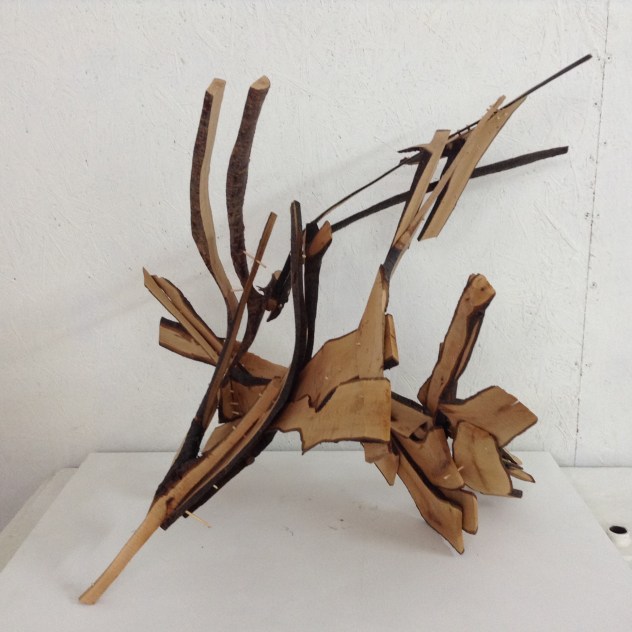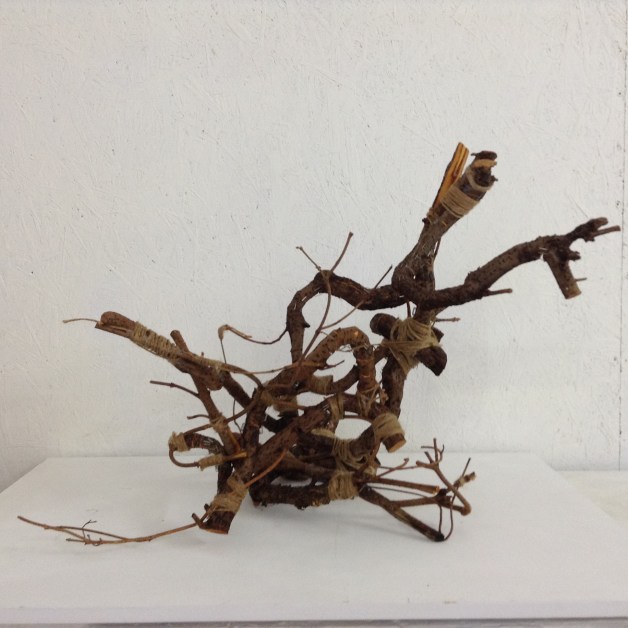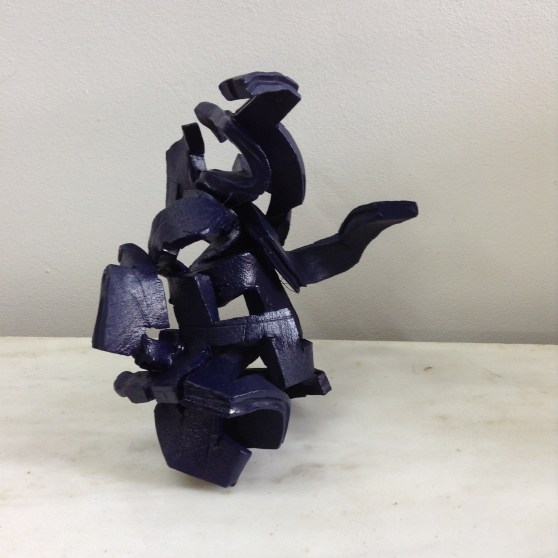Brancaster Chronicle No. 52: Alexandra Harley Sculptures
17th September 2017, the artist’s studio, London.
Taking part: Anne Smart, Anthony Smart, John Bunker, John Pollard, Alexandra Harley, Robin Greenwood, Sarah Greenwood, Hilde Skilton, Mark Skilton, Noela James, Richard Ward.







I have been trying for a week now to say something about Alex’s sculpture.
The two wood pieces, particularly the one made with a bandsaw, are in my opinion well worth continued discussion, and on the face of it could have run very profitably with the extensive debate prompted by Tim Scott’s pieces and all that stuff about material and space.
Then along came Robin’s description of The Fourteen Discs painting by Heron[ over on abcrit ] . I got it immediately. What he was saying about it had taken form as words.
Why couldn’t I come up with something more about these two wood sculptures?
These pieces are not like ‘any thing or anything ‘and seem to be resisting any attempt to describe them beyond what was said in the Chronicle itself.
Are they spatial ? Yes,but I can’t describe that space in text form. Are they specific? Yes, very.
Is it that she has crossed a line here? What I can say is that these do not ‘ shout out ‘as any kind of image but as I said about Tim’s they do lend themselves to thinking and feeling your way around them, even in a photograph, and certainly in your imagination. I think the description of the Heron painting ,for me, took something away from it.
I am suggesting there are no words coming into my mind that would unseat these works or to explain them either into the literal world or to flag up just how good my favourite one is, or might be !
For me there are five individuals being discussed in the Chronicles who make sculpture[ much as I wish it were more inclusive of what is out there]
This suggestion about Alex strengthens my view as to the ever broadening range of approach in abstract sculpture that I know we are all looking at today .
LikeLiked by 2 people
Well, I don’t think I could describe Alex’s sculpture in the same manner that I described the Heron, so I think we agree (?) that is a good thing. Perhaps that is a measure of the progress from the high modernism of Heron to something new and more complex and less expected that begins to emerge in the present. Seems the further we go (in abstract art) the less we can say we know. So what does clarity mean? Or wholeness? Can we ease off on those – for a while? Maybe not…
I too like the “bandsaw” sculpture. I would have liked to look at a few of them.
LikeLike
The two wood sculptures provided plenty of interesting contrasts to discuss. ‘Wood’ (‘Bandsaw’) is a rather beautiful sculpture. It has an interesting tension and slightly springy feel. The material itself is beautiful and I enjoyed the contrasting views, whereby the same object was giving you a different visual felt sense. In contrast ‘Wood, String’ (and staples) was les graceful and has a slightly awkward gnarled look and feel to it. Visually and spatiality perhaps it wasn’t as complete, integrated, balanced, but it had its own strengths, partly down to the contrast in materials, but also its actual form.
So what way is better? Which is better?
I don’t know but both are worth pursuing (and/or combining?).
LikeLike
John.
If your question had been ,which of the two sculptures is the most interesting today? the one that asks the questions of us,and not of Alex, but how we see them,then for me it would be the ‘bandsaw’ piece. The other sculpture still references the natural world and the natural consequences of processing timber. The other[ the band saw piece ] contains real decision and interference by process and construction. That alone has the only necessary lineage to sculpture making that any work needs.That is,the decision to saw the log up into specific lengths which immediately have variety of shape and are suggestive of variety of intent. !
These essentials of sculpture are naturally introduced into the material by the cutting more deliberate , more considered, more inclusive of consequence ,which flows from intent, than the ‘riven’ pieces of four years ago.
Sawing with a band saw cuts across the natural !
In this piece the first acts of sculpture are instrumental in the first response to the material.
So Alex has already established for her work an open ended connection to certain fundamentals of sculpture without all of the ‘who’s ,whys and wherefores ‘ normally deemed necessary in critique of new work. It is this direct physicality, through action of approach to material, that establishes its right to be seen and thought of as sculpture and from that basis a discussion of value has begun.
So I am suggesting that the particular of those very qualities of how her sculpture is built , it’s fragility, is our direct access to its meaning.
So what has long been thought of as a literal weakness in the work is now an open door to what its all about.
LikeLike
Tony,
This makes sense.
I think you are a little more of a purist than me but I agree that Bandsaw is the more accomplished sculpture. However, I think that the question of how much the other sculpture is let down by its materials is not straightforward, as I can imagine a sculpture involving a mix of ‘natural’ and more manipulated materials working in a way where its naturalness is lost as part of its new configuration (out of the natural world and in relation to other materials/structures).
Hence, I would not want to block this possible avenue for Alex to explore.
LikeLike